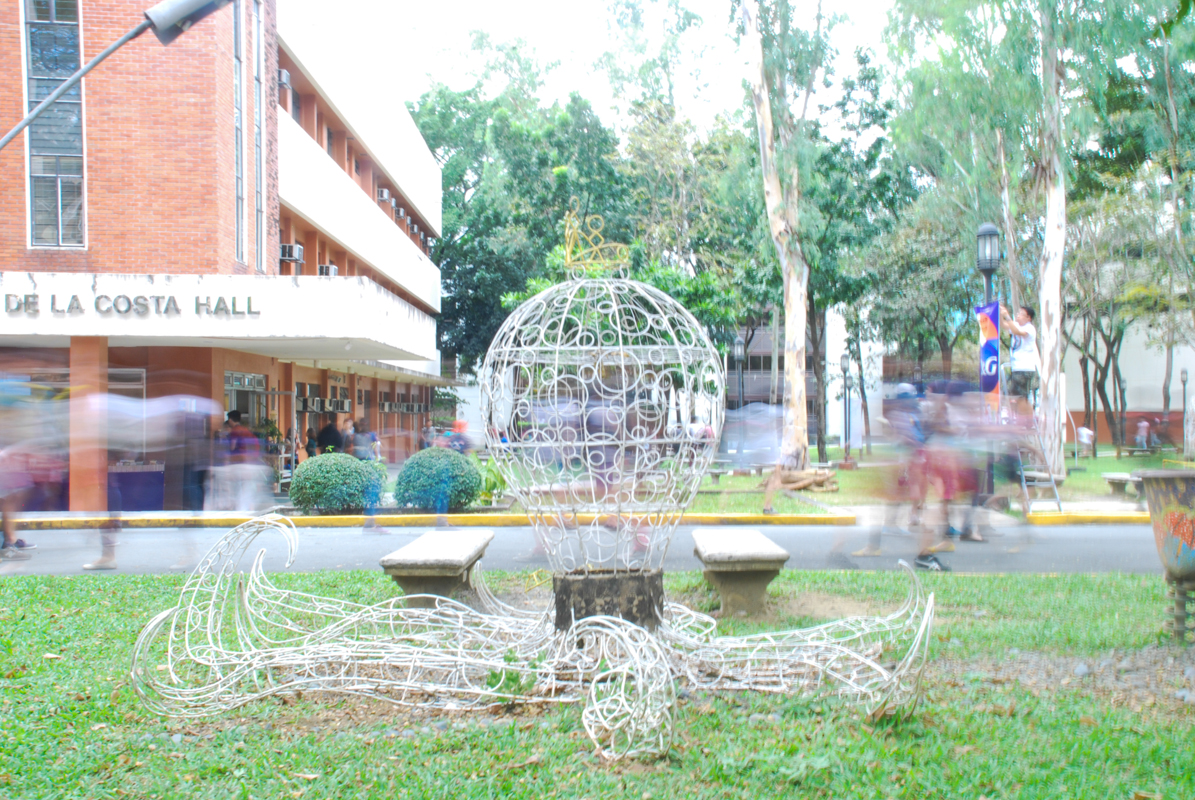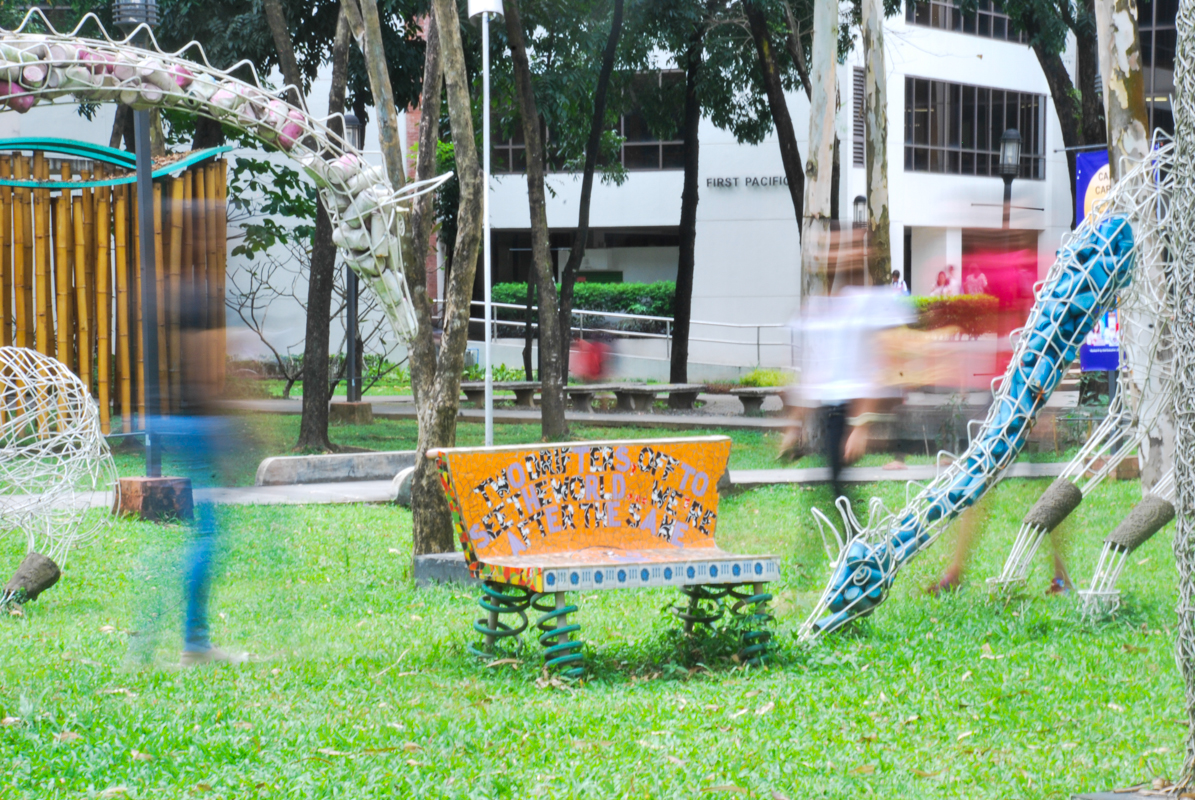As strange as they might seem at first glance, the enormous metal jackstones occupying what used to be an empty space behind the Social Sciences Building have become an everyday sight for Ateneans. During the day, some students take advantage of their undeniable selfie potential, clambering on top of these larger-than-life structures for a picture or two. At night, the jackstones glimmer from the pin lights positioned beneath them and the headlights of passing cars.
This installation, entitled A Child’s Memory, was created by installation artist Anton del Castillo. It is certainly not the first of its kind in the Ateneo; in fact, between Plet Bolipata’s imagiNation and Niccolo Jose’s Blue Eagle’s Nest, the university has a colorful history of commissioning artists to set up imaginative works that make passersby stop, stare and reflect.
Where work meets play
According to del Castillo, who is also an assistant professor at the University of the Philippines Integrated School, his works usually touch on the themes of religion, war and play. A Child’s Memory clearly falls into the latter category, as del Castillo shares that the piece was actually conceptualized upon comparing his own childhood experiences with his children’s.

![LARGER THAN LIFE. Art installations like <italicize> imagiNation and <italicize> A Child's Memory add character to the Ateneo campus. [PHOTOS BY PIA B. GUBALLA]](http://theguidon.com/1112/main/wp-content/uploads/2015/02/010815-Art-15.jpg)
LARGER THAN LIFE. Art installations like imagiNation and A Child’s Memory add character to the Ateneo campus. [PHOTOS BY PIA B. GUBALLA]
Coincidentally, the whimsical quality of del Castillo’s work complements Bolipata’s quirky wire animal sculptures that can be found just a few steps away. Inspired by the story of Noah’s Ark, imagiNation was first exhibited at the Bonifacio Global City Offsite Gallery in June 2012.
It would never have made its way to the Ateneo had Rica Bolipata-Santos, Bolipata’s sister and the director of the Ateneo University Press, not intervened.“When I was about to move the animals and tubs back to the farm in Zambales where I live, my sister suggested I take them to the Ateneo grounds,” Bolipata recalls. “She said this would widen my audience to include young minds who will be thrilled to have the art pieces dotted across the campus.”
Since the transfer was made in December 2012, elephants, giraffes, cats and octopi have become a common sight for those walking to and from the Ricardo and Dr. Rosita Leong Hall, Horacio de la Costa Hall and the New Rizal Library. Aside from being aesthetically pleasing, these figures are also functional; students often hang out around the tiled tubs that separate each pair of animals. In a statement on imagiNation, Bolipata says that much like Noah’s Ark, it is intended to offer solace: “Visitors will be able to sit comfortably in the bathtubs, knowing that they have been rescued. They can relax as the stresses and strains of their daily lives subside.”
Vision and execution
Within the Ateneo campus, bringing an art installation to life means working with the Ateneo Art Gallery (AAG). Gallery Assistant Ria Aguilar explains that while artists usually submit proposals that are subject to the AAG’s approval, there have been instances where certain artists, like those who have been shortlisted for or who have won the Ateneo Art Awards, are personally invited by the AAG. “Depending on where you stand, that requirement [of working with the AAG] does seem limiting not only for the artists but for the institution as well,” she explains. “However, we have to keep and satisfy a certain status quo and aesthetic.”
[blockquote author=”Niccolo Jose, Visual Artist” pull=”pullright”] You can’t just make a sculpture somewhere else and then dump it and install it there. You really have to talk to the people around you.[/blockquote]“When a proposal is approved or an artist invited for a show, we take note of the special needs of the artworks,” she adds, as each piece has its own specifications in terms of size, placement, transportation, installation and documentation. “As much as possible, we determine what are the possible damages and think of how to address issues that might arise in installing and showing the artwork.” This is done with coordination with the Facilities Management Office, the Office of Administrative Services and the Security Office.
According to Aguilar, the curators and artists usually select “big, dead spaces” as the venues for their exhibits; in doing so, these drab spaces are suddenly transformed or maximized. This is precisely what happened when Jose built Blue Eagle’s Nest, a giant nest sculpture made of wood and soil, on what was once a cornfield next to Gate 3.5; built for the ground blessing of the The Areté or the Ateneo Creative Hub last April, it symbolizes how this space will be a nurturing one for the Ateneo community.
“When you make an art piece, you always have to consider how you’re going to display it or where it’s going to be seen from different angles,” says Jose. In the case of Blue Eagle’s Nest, “I was really looking at the big road, the traffic, plus [the Regis Center] in front—how would it look like from up there?”
This particular piece was a challenge for Jose, and not just because of his two-week deadline or the fact that this was his first time to create an art installation in Manila; his sculptures are usually exhibited at the annual Malasimbo Music Festival in Puerto Galera. For one, he was told that the sculpture would be torn down after four months, so it had to be easy to dismantle. Also, instead of letting his creative juices entirely dictate how the nest would turn out, blocked off areas for the stage and tents for the ceremony limited his movements.
Despite these parameters, Jose’s collaborative spirit still shined through. “Usually, when I do an installation, I befriend everyone in the property, so all the security guards knew me,” he shares. “You can’t just make a sculpture somewhere else and then dump it and install it there. You really have to talk to the people around you.”
Making an impression
The collaborative nature of an art installation does not end once it has already been produced. If anything, this is when it begins to ignite much discussion and debate. This is good news, especially for the artists themselves. “People, specifically young people, learn about their names and their works, and it gets spread around,” Aguilar emphasizes. “The Ateneo is an institution, so people from other places also get to see their works, and having a wide variety of audiences is a good leverage for any artist, may they be newcomers or established artists.”
Lazir Caluya, an information design sophomore and associate design editor at Heights Ateneo, agrees that such installations have indeed been effective in getting more people to talk about art. “Since installations like this are outside the gallery and more public, more people notice them,” he says in a mix of English and Filipino.
Each installation interacts with its audience; for Ateneans who sees these artworks on a daily basis, they can be interpreted in any number of ways. “[A set of jackstones] usually comes with a ball that is picked up in tandem with one jackstone [at a time], but no ball is present in [A Child’s Memory],” notes Colleen de Luna, an information design freshman. “The sculpture serves as a reminder that we—especially as college students—try to sort everything out at once and that maybe we should find the ‘ball’ in our life and take everything step by step.”
While other people may have different interpretations, de Luna believes that there is one thing we can all agree on: The unique personality that these installations give the campus. “They set our campus apart because I don’t think other schools have them… I know that Ateneo is known for its humanities programs and core curriculum, and I think these installations work hand in hand in culturing the Atenean.”







